

 The Accurate Reloading Forums
The Accurate Reloading Forums  THE ACCURATE RELOADING.COM FORUMS
THE ACCURATE RELOADING.COM FORUMS  Guns, Politics, Gunsmithing & Reloading
Guns, Politics, Gunsmithing & Reloading  Cast Bullets
Cast Bullets  How fast can you push a cast lead bullet?
How fast can you push a cast lead bullet?Go  | New  | Find  | Notify  | Tools  | Reply  |  |
| one of us |
How fast can you push a cast lead bullet? If you are only shooting paper? If you plan on shooting live stuff? I understand you have fast bullets and soft bullets. I understand that will affect my question, but I don't understand how it will affect this. Does bullet diameter make a difference? I have 22cal cast bullets. I have 30cal cast bullets. I have 452cal cast bullets. I have 458cal cast bullets. | ||
|
| one of us |
You should get ahold of one of the many fine publications concerning cast bullets. All of your questions. and some you haven't asked, will be answered. | |||
|
| One of Us |
You could talk to some of the guys over at Cast Boolits. The Brinnell hardness of the lead, the fit to the groove diameter, the bore finish and the rate of twist all after the behavior of the bullets. | |||
|
| One of Us |
I'll try and help you with some info. In 30 caliber specifically 7.62x54 I shoot the lyman #314299. This bullet cast out of wheel weights and 2% tin added for better flow of the alloy and cast hot. By hot I mean the bullet is evenly frosted I get 1600-1800fps with this bullet. I use IMR 4759. Thebore of my finnish M27 measures .3115 and Isize the bullets to be used in that rifle to .3135. Or 2 thousandths over groove size. Javelina is the lube I use. Now in the 45 calibers (in my case a ruger #1 in 45-70 I shoot the lyman 486gr round nose gas checked bullet. I size and lube them to .461 which is again 2 thousandths over groove diameter. I've shot these at 1600fps and while the recoil is not objectional you know you just launched a heavy hunk of lead. You can of course send this bullet at close to 1800-1900 fps. Your shoulder will tell you when its time to stop. This is cast bullets here so you can see the relationship. Small bullets weighing in at about 210grs and large bullets at close to 500grs. Naturally the heavier bullets at lets say 1600 are going to generate more rearward thrust than the lighter 210gr bullet at the same speed. The 7.62x54R Finnish moisin I use for paper punching. The 45-70 with the bullet described is/can also be used for paper punching and big game hunting. The deal with the 45-70 is that you are starting out with a large bullet at a velocity that gives you good accuracy, velocity and penetration. But even with the higher velocity you'll still have to get close (not more than 200yds) because of the rainbow trajectory of the big bullet. The trajjectory won't be as bad as when one would use a 405gr factory load but you'll have one nontheless. This you will have to make allowances for. Both barrels have well fitting bullets, the bores on both rifles have excellent to new bores. What you want to do when you get your load worked up, lets say the 45-70. Sight in at lets say 100yds, next target might be 150 yards and the last target is at 200yds. With the 100yd setting you should find your bullets have a nice center mass grouping. At 150yds you notice that your groups have dropped down lower on your target and those holes aren't so close to each other as they were at 100yds. Now comes the fun, shoot the 200yd target with no sight changes. Now you find a really significant dropand your shots are spaced farther apart. In the lyman cast bullet handbook they give you the ballistics for both of these bullets. Do some reading and some time on the range. Experience you will need. I shot my ruger in 45-70 against a fellow shooter who was shooting a pedersoli sharps in 45-70. I ran out of sight adjustments just going from 100 to 200yds. I was using the adjustable sights that came on that rifle. He on the other handwas using a very expensive set of vernier target rear sight and a globe front sight. Here I am fooling around with the crummy ruger sights and there he is making minute adjustments on his tang sight. He beat the pants off me that day.We both had fun but ballistically it was not a real contest. Those sights when dialed in can adjust for very small increases in both elevation and windage. We both knew the outcome of the contest before we ever started. Plus his shooting offhand with that rifle and load combinaation is was better than mine. But it gets even better. Out comes the spare rifle all tricked out like the first one. So now we are more evenly matched. He still cleaned my clock. Why?. He had the experience and better familarity with the riflehe's been shooting that the loaner I was shooting. You gotta get at the range and while shooting at different distances make notes on a small pad. How much drop, how fast the wind was blowing and where was it coming from. Even such things as having an overcast sky will afect how you shoot. My deer rifle will launch a 165 nosler 30 caliber ballistic tip at slightly over 2800fps.You may thing that wind has a little to do with where your shots are grouping at the 200yd target. So practice, practice and practice some more. You gain valuable experience each time you go out. This makes no difference if you are shooting a 30-06 or a 7mm magnum. I can give you an exact round count out of just about every rifle I own. I fire 50 rounds off each time I go to the range. Yes the rifle does a great job, but its the guy behind the rifle who's gaining valuable experience. They all work hand in hand. I used to hunt in a swampy area in pennsylvania. You were lucky to see a deer far away as the area was full of blowdowns and dropped trees. Shots were always closeup and less than 100yds distant. Down here in louisiana we have swamps galore. Some guys hunt the pipelines. Your shots can easily go 300yds or so because the area around the pipelines are usually well cleared of trees and other vegetation. Different hunting areas demand different hunting tactics. Sorry to be so long winded. And do hope you get something out of what has been said. Regards, Frank | |||
|
| one of us |
I believe you have answered one question. I need less velocity to get better accuracy. I am pushing the pullet like a jacketed bullet. I would like to see terminal effects with lead bullets at different velocities. I know a certain bullet I like to use in .458 doesn't hold up when pushed over 2400FPS (probably lower). I have no idea how commercial cast will do. CISSP, CISA, CRISC looking for a IT Security/Audit Manager spot | |||
|
| Moderator |
i have driven GC .510 bullets to 2400fps .. and plain based .550 to 2300 .. leading starts about 2200, in which i mean 10 shots and it needs to be cleaned... other guys might say that started at 1750, which is okay too opinions vary band of bubbas and STC hunting Club Words aren't Murder - Political assassination is MURDER Information on Ammoguide about the416AR, 458AR, 470AR, 500AR What is an AR round? Case Drawings 416-458-470AR and 500AR. 476AR, http://www.weaponsmith.com | |||
|
one of us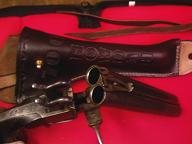 |
Like the other guys said, there are many variable to consider. One of them is lube. I have pushed a 190gn GC bullet to 2700 fps in my 30-06 with no leading using my Carnauba Red bullet lube. With Rooster HVR I only got to 2250 fps before the barrel was leaded and fouled badly. We offer free samples so you can try it yourself. If you don't want to cast your own, there are links on my site to companies who use our lubes. | |||
|
| One of Us |
You can push a cast bullet as fast as any other bullet of equal weight. The question is; do you want accuracy with speed? If so then "how fast" is a moot point. What you need to do is set an accuracy criteria based on the accuracy your rifle is capable of with quality jacketed bullets. Then perhaps we can answer the question. Larry Gibson | |||
|
One of Us |
[Perhaps I can shed some light. I test fired some of my cast creations and recovered the bullets (firing tube). These were by no means fast as I wanted whole bullets to see how the rifling was working. These pics show bullets fired in two rifles. The one, a two-groove 303 Brit, the other, a five-groove. The bullets are bigger than groove diameter at the bases but taper down to fit the throat snugly. They have no lube grooves but were coated with waxy-lube. There was no leading of the barrels.  Five-groove barrel. The second bullet was fired without a gas-check. Note the flame cutting. (If you look closely you can see that the first bullet in the pic has the gas-check the other way round!) 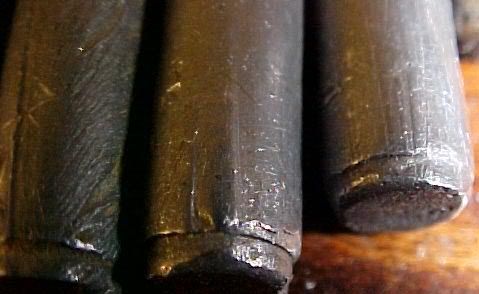 Two-groove barrel. The second and third bullet lost their gas-checks. Note the flame cutting. The third bullet has had all the groove ridge burned away!  This one fired in the two-groove was a bit hotter. Note the flame cutting! Regards 303Guy | |||
|
| one of us |
I can get accuracy,speed and terminal affect with jacketed bullets. Given the option I will take 1. Accuracy 2. Terminal affect 3. Speed is not needed. If I can't get 1 and 2, then these lead slugs are only good for target practice so accuracy is #1. | |||
|
| one of us |
That is very interesting. How fast? How do they group? Do they all shroom? I assume this load is capable of taking a deer? CISSP, CISA, CRISC looking for a IT Security/Audit Manager spot | |||
|
One of Us |
This is still early days of bullet development. These are from a mould I have recently made. The bullets were test fired into a 'test tube' which I have in my shed. So, at this point in time, I have not range tested them. I have made up a batch of them for testing and will let you know how it goes. (They are hollow point and I hope to get 1900 fps or more. At that weight, they will most certainly take a deer - if they shoot straight!) Note my typo!  The flame cutting is severe so I would not expect any accuracy from this bullet in the two-groove barrel. But I won't know for sure unless I try it. Regards 303Guy | |||
|
| One of Us |
ddunn Very well, accuracy be your #1 priority then. Larger calibers can generally be driven faster with accuracy for two reasons. First is the larger the caliber the less small defects (given the same size defect) effect them vs smaller bullets. Second is that the larger calibers (35+) generally have a slower twist. Your best accuracy with velocity with regular cast bullets is going to be between 120,000 and 140,000 RPM. You can compute the RPM by knowing the twist of the barrel and velocity; RPM = Velocity / (12/twist) X 60. To achieve accuracy above that requires special loading techniques and a specially designed bullet. Or a slower twist barrel to keep the RPM down. As an example; consistent 2 moa accuracy at 100 yards is fairly easy to obtain with accurate bolt action rifles using regular cast bullets (GC'd and a BHN of 16+) loading with medium burning powders (or the slower fast burning powders (5744,4759, 4227, etc). With a 10" twist barrel best accuracy will come around 1700-2000 fps. With a 12" twist barrel you can increase velocity to 2200 fps or so. With a 14" twist barrel you can further increase velocity to 2300-2400 fps and maintain accuracy. It isn't easy whn you get above 2000 fps but it's not all that difficult either. Do you have a particular cartridge and barrel twist in mind? Larry Gibson | |||
|
| one of us |
"How fast can you push a cast lead bullet?" This kind of a loaded question. What are you trying to achieve? I would guess as fast as possible with acceptable accuracy? Each and every barrel will be different. Some will fly faster than others of the same caliber. This is somthing you yourself and no one else can find out. I have had good luck thus far in most rifles by using a start load for jacketed and moving up a bit at a time. Same as any other load development. "If you are only shooting paper?" I have found the lyman manuals with a listed "accuracy" load to be pretty close most of the time. Speed doean't always equal accuracy. "If you plan on shooting live stuff?" IMHO, the best accuracy you can get with a midrange speed and a proper bullet, ala a good FN design. I CB is not meant for the most part to expand like a jacketed. I explain to others like this. Which would hurt worse and deliver more energy, a finger at 300fps or a fist at 200fps? On to some variables. Fit is everything. Slugging a bore and throat is a must to achive what I believe you are after. You mention the selection of bullets you have from 22-458. For instance your 458 CB's amy be sized and lubed at 459, when you throat would do better with a 460. Somthing elese that I just can't believe wasn't brought up by some of the other posters. Clean the BORE of ALL jacket material, ALL of it. I know there are a lot of guys that swap back and forth with no difference in accuracy. There are also the ones that "clean" leading by shooting a jacketed bullet to blast it out. Anyone runs a a jacketed bullet through one of my CB guns, is liable to get an arse whupping. As to the jacketed bullets to clean. This past year I was doing some load work with a new TC 357 mag barrel. I shot several different CB loads through it and most shot excetionally well. Yes I was shooting some unpublished very hot loads. I won't say it was an alloy problem or a lube problem, more than likley a speed as I think the bullet was skidding. HMMM, I have some average jacketed ammo that I had that really didn't show promise. I will try the shoot to clean method a lot of folks brag about. Biggest mess I ever had in my life. Ironed the lead into the smears deep into the grooves. Took several weeks of soaking in KROIL to get it clean. Then several hundred rounds through it to re season the bore, before regular accuracy came back. #1 is bore size and proper sized, and bore condition #2 would be lube, I suggest find one you like and stick with it. #3 would be alloy 303guy, very interesting pictures. not to knock your casting, but the flaws in the one looks to be foreign material of some kind. I expect no less on a CB than I would a jacketed bullet. I would suspect the inverted GC was not seated fully? The gas cutting, May be bore issues in the milsurps, dips and dives in the bore, internal condition? I have ran some WW alloy FWFL with an old RG4 mould in my 1903 at speeds of jacketed ammo. My berms ar not kind to most of the bullets I he retrieved. No sign of any gas cutting I have ever seen. I would think with gas cutting one would sure to have some serious leading issues. | |||
|
One of Us |
jsh, you are quite right. That first bullet had some inclusion from the mould. The inverted gas check is actually pre-soldered then place in the mould. The inclusion came from that - flux! The third bullet shows some folds due the mould or lead being too cool. The flame cutting is probably as you suggest, a bore issue. There is rust in the grooves and that is probably causing the leak. I cannot actually discern any lead fouling in the bore. None came out during cleaning. I suspect that lead that is flame cut off does not actually foul the bore. That particular bore is due to be lapped. After lapping, the muzzle will be trimmed back and crowned. Then we'll see what it can do. I have never had any success with the five-groove barrel with CB's even though the bore is mint. But then I have never tried oversize/throat size bullets in it before. I have a batch for range testing - without defects. Reject bullets were used in these initial test. Not how the flame cutting begins at the clearance formed as the driving lands wear into the bullet creating a clearance on the non-driving side. All observed flame cutting begins there. The third bullet in the pic has no flame cutting but one can see on the gas check how the driving land has cut across it. On another sample, the gas-check did not have that 'cutting' but instead, turned on the bullet so that the groove on the bullet was wider than the groove on the gas-check. Regards 303Guy | |||
|
| one of us |
I would be interested as to your findings with the 303 Bri. I have had a few guys that have 303's shooting CB's tell me I should have one to fool with.Thus far I have been pretty choosey as to what guns I fool with using CB's. A couple of them I tried and may have gotten lucky as to others results. Nameley a 6.5x55 and the 7.65 Argentine. I had read and heard both could be a PITA. I myself wanted as much accuracy as I could get. The Swede has shown excepetional excellent accuracy out to 200M. After that it seems it may be picking up twist, as windage goes crazy. The Argentine is showing good promise, as I was warned about throat and neck issues. I made my own brass from some 06 brass and then neck turned them all to fit my combo. What a pain to make 100 cases and pretty much going into this blind. However it does seem to have paid divideneds so far. The 303's have always made me a bit wary as to bore quality that one will find, even in an exapmle as good as you have. Post up on your findings, as I read alot more than I post. jeff | |||
|
One of Us |
Regards 303Guy | |||
|
| One of Us |
What weight cast bullet and what velocity are you using in your 6.5 Swede? | |||
|
| one of us |
It is an RCBS 140. I forget speed but it is mild, I think, don't quote me, the load is 11.0 of unique. jeff edited for corrections | |||
|
| One of Us |
Mild by the velocity, but over the max that the Lyman has for Unique. I can push a 140 Saeco well over 2000 fps with great accuracy. I use H4198 and is in a 6.5 Grendel out of an AR15. | |||
|
One of Us |
My first batch of loaded rounds ready for testing. These will get a dip of molten waxy-lube. They may be a bit hot for lead. They are supposed to be in the 2000 - 2100 fps range. That's because I did not want to load too low with a slow burning powder. The bullets are 220gr hollow point nose cast and fit the throat closely. So we'll see! (You can see that the sprue did not come off properly in third one in the pic). 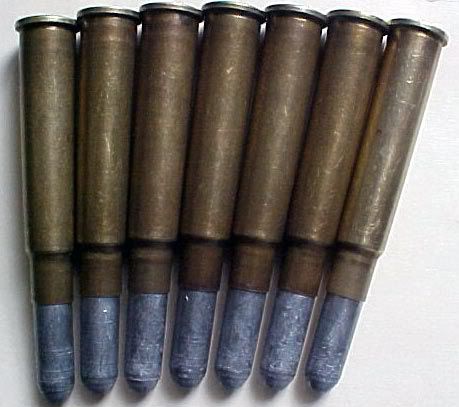  Regards 303Guy | |||
|
| One of Us |
Pretty interesting and I'm anxious to hear the results. Good luck. | |||
|
One of Us |
Thanks. My contact had to go away for work this weekend so I shall be looking for a new venue. Here is a lubed bullet. 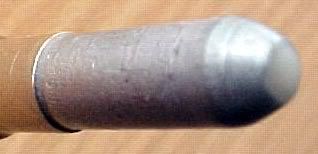 And one with a different lube. 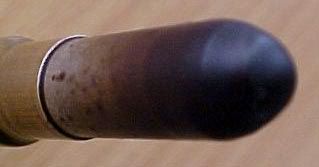 The lube is quite tough and does not come off during chambering. It contains 'smoke stopper engine oil treatment'. This one has been chambered and extracted. 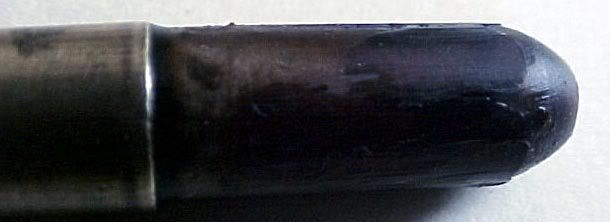 Regards 303Guy | |||
|
| One of Us |
303guy, well I answered one question. As I see it you are using very overweight bullets for the caliber and using a slow burning propellant. First off you should be concerned about accuracy. If planning on a super hunting load that would bemy first concern. Second would be velocity. I'm taking a guess here that your velocities are probably running in the area of about 1600fps or slightly faster. If the accuracy isn't there what now?. If we are talking about practical accuracy 3-4" for deer then your halfway home. Some lever actions don't do as well. Recoil/recovery between shots. If the recoil is so bad that you can't keep your sights on what you just shot what good is that.Consistency of your loads, can you count on getting the same accuracy time after time or are you getting erratic accuracy. Lot of variables start to creep in in doing something. And last but not least when playing around with something new, change only one variable at a time. If you change only one variable and accuracy starts getting better that change was for the good. But starting messing around with multiple variables and your well thought out developement plan can go south in a hurry. Don't think I'm condeming you. Quite the contrary. Thing its really nice when someone stumbles on to something that has the potential, and I think your set up has that potential. So keep slugging away as myself and others are interested. And what size are your bullets in relation to your rifles bore dimensions. A lot of casters use a rule of thumb and say they like .002 over the nominal bore size. have fun and keep us posted. Frank | |||
|
One of Us |
Thanks for the advice and encouragement, Singleshotlover. Bullet base - 8.05mm, 6mm behind nose - 7.72mm. Bore diameter 7.72mm, groove diameter - 7.95mm. (Converting; base - .317, nose - .304, bore - .304, groove - 0.313) The reason for the oversize bullet is to get it to fit the throat. Regards 303Guy | |||
|
one of us |
Hi 303Guy, your project looks very interesting. It breaks into the question of How much Lube do you really need??? When I was testing bullets in my Taurus 454, one of the moulds had most of the lube grooves accidentally wiped off while being turned in the lathe. It was a big 2 cav mould and needed the extra heat in both cavities to make good bullets. So I loaded and shot some of the bullets just because they were there and they shot great and left the barrel clean. I was useing Javalina brand 50-50. I tried searching for "Smoke Stopper Engine Oil Treatment" but didn't find anything. Could you post the manufactures name and the product name? TIA I was working with a guy a couple of months ago that was resizing 22lr match bullets and needed a light lube to coat the bullets with afterwards. I melted some of my Carnauba Red stick lube and added mineral spirits. With the lube melted I could dip the bullets and hang upside down to dry. After a couple of days it left a fairly durable thin film of lube on the bullets. I'd be happy to send you a stick of lube to try if you want. | |||
|
One of Us |
Lar45 Thank you kindly for the offer of Carnauba Red. I would appreciate it. May I suggest that I try out my full power loads with my 'waxy-lube' first. In the new-year I would like to try out the Carnauba Red. I did look for some in my gun shop but did not ask if they had or could get it. My reason for the wax thing is that being a 'stiff' wax, it holds my hornet bullets fast.
That is a generic term I use. The product I use is called "Smoke Stop" by Nulon. It is Australian. Others are Wynn's, Bardahl No-Smoke, STP etc. I did not know until reading on this forum that these 'smoke stoppers' actually mixed with wax. My first tests were with just a healthy swab of 'smoke stopper' on the bullet. It seemed to work. The bore stayed clean and shiny and there was no sign of smearing on recovered bullets. But the real test will come with full power loads. I can't test those in my firing tube as the volume of gas produced lifts it apart and the bullets get pretty destroyed anyway. ddunn I seem to have hijacked your thread! Hopefully I am helping to answer your original question. My interest in your thread is exactly that - how fast can you push a cast bullet! (I want the speed only to give me some usable range). I am expecting flame-cutting problems with my bullets because of the absence of that first lube groove that should or might halt the flame cutting. I am trying to seal my bullet in the bore by going somewhat oversize. I can only get 30cal gas checks so I flare them a bit to make them seal better. Another trick I am planning on trying is to use brass washers as a gas check. (Might be a bit tricky to cast in situ but 'tinning' might work. Another is a coil of copper wire in the mould - also tinned). I also plan on hardening the alloy with dissolved copper. So far, my attempts to dissolve the stuff in lead have failed. I tried 'tinning' the copper then leaving it in the molten lead but very little if any dissolved. Regards 303Guy | |||
|
| one of us |
Don’t worry about it. I am still learning. As a newbie at this, although the thread twisted and turned it has stayed at a level I still understand. Rather than trying to twist this one back on track, I will ask my new group of questions in a different thread. Keep this one going with how fast cast can be pushed with reasonable accuracy. CISSP, CISA, CRISC looking for a IT Security/Audit Manager spot | |||
|
One of Us |
They do that and a heap of new information emerges. It's great! Regards 303Guy | |||
|
| One of Us |
I always thought RPM's was a non-jacketed bullets biggest enemy.....barrels twist rate/fps ratio to RPM = lead vaporizeing just out of the barrel.... ________________________________________________ Maker of The Frankenstud Sling Keeper Proudly made in the USA Acepting all forms of payment | |||
|
| One of Us |
The cast bullet's biggest enemy is how tough the bullet is, in other words the strength of the alloy to the task at hand, and how well it's fitted and lubed. High velocity high rpm cast bullets can work and achieve very good accuracy. That it can't and that there is a rpm limit is a myth. Let's just say it's harder to do for the less accomplished. | |||
|
| One of Us |
So your saying the gray cloud "poof" is a myth? ________________________________________________ Maker of The Frankenstud Sling Keeper Proudly made in the USA Acepting all forms of payment | |||
|
| One of Us |
"That it can't and that there is a rpm limit is a myth. Let's just say it's harder to do for the less accomplished" Joe There you go again spreading the "myth" about an "RPM limit". I'm not sure there is a "limit" but there sure is a RPM threshold where accuracy goes south. We've all been through this before and know that. It's not a limit but is a threshold that can be pushed higher if one goes about it te right way. Reasonable accuracy is quite possible at high RPM but the best accuracy is going to be in or below the RPM threshold. However, I think Ted is asking about bullets disintegrating in flight from high RPM. It does happen with jacketed bullets (the thin jacketed varmint bullets in fast twist rifles) and no doubt would happen to cast bullets of soft alloy or just plain lead if pushed that fast at that high of RPM. The problem is that with cast bullets the other limits when shooting a soft lead only (not alloyed) bullet at 3200 fps in a 7-9" twist become very problematical. Perhaps since you are not one of the "less accomplished" you could show us some 2 or 3 moa 10 shot groups out of your 7" twist AR15 .223 at 3200 fps with a relatively common .224 cast bullets like 225415, 225438 or 225462 that are cast of soft, pure lead. That would answer two questions. The first; is there and RPM threshold? The second; do bullets "blow up" from said RPM as ted is asking? Larry Gibson | |||
|
| One of Us |
I personaly have never seen the gray cloud just heard about it....I'm not sure but maybee I even read about it some years back in a Lyman book. Not sure though. ________________________________________________ Maker of The Frankenstud Sling Keeper Proudly made in the USA Acepting all forms of payment | |||
|
| One of Us |
It's easy to see the gray "puff", just load some 50 or 55 Hornady SXs up to 3200 fps and shoot them in a 7-9" twist .223. Or load them to 3600+ fps in a 22-250 or .220 swift. The 100 gr Hornady 6.5 varmint bullet at 3200+ fps out of Swede with 7.5" twist will sometimes do it also. The Sierra "Blitz" bullets also will "puff" about 3o-40 yards out in the .22 centerfires. Those bullets all have very thin jackets and pure lead cores. Cast bullet alloys have a much higher tensile strength (because of the alloy) than pure lead so the RPM would have to be correspondingly higher to spin them apart. Maybe Starmetal will push pure lead cast bullets out of his fast twists at those velocities for us and find out? A PP'd bullet would prevent leading at such velocities though. How about it Starmetal? Larry Gibson. | |||
|
One of Us |
After fire-lapping my rifle bore, the flame cutting seems to have stopped. I tested some 220gr cast bullet loads today in my two-groove barreled No.4 and the results were very encouraging. (See my thread on cast bullet development). Regards 303Guy | |||
|
| Powered by Social Strata |
| Please Wait. Your request is being processed... |
|
 The Accurate Reloading Forums
The Accurate Reloading Forums  THE ACCURATE RELOADING.COM FORUMS
THE ACCURATE RELOADING.COM FORUMS  Guns, Politics, Gunsmithing & Reloading
Guns, Politics, Gunsmithing & Reloading  Cast Bullets
Cast Bullets  How fast can you push a cast lead bullet?
How fast can you push a cast lead bullet?

Visit our on-line store for AR Memorabilia

